Charger GoalZero Guide10Plus


GoalZero has a line of product for mostly outdoor use, this includes chargers, power banks, solar panels, lights and other stuff. Here I am looking on a combined AA charger and power bank.

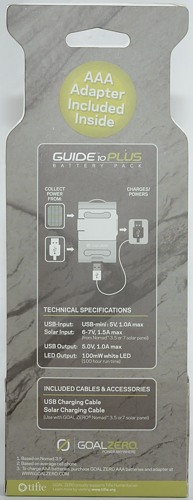
I got the charger on a piece of cardboard with a box for accessories.

The contents of the pack: The charger, 4 2300mAh GoalZero cells, an instruction sheet, a short form instruction sheet, a inlay for AAA batteries, usb cable and a cable for GoalZero solar panels.

All connections and user interface is placed at one end of the charger, they are:
- Red/green Led to show charge state, light patterns are explained on the bottom of the charger.
- Switch to select mode: off/charge, power bank on, flashlight led on.
- Power bank output usb connector.
- Flashlight led, it is a white led.
- Round solar panel power input connector.
- Mini usb power input connector (This means cable cannot be with the mobil phone).

Bottom of charger explains the led and a few other details, i.e. you got the important stuff from the manual here (Very nice).

On the other end is a steel wire. It is possible to run a strap under it and tie the charger to the outside of a backpack.
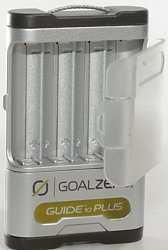
The charger has a lid, making it fairly easy to keep the batteries in the charger, even if it is on the outside of a backpack.
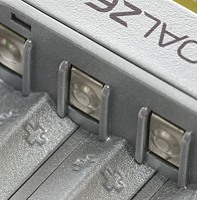
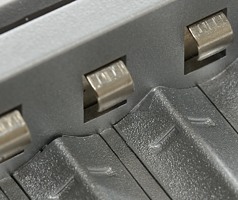
The slots are only designed for AA batteries.
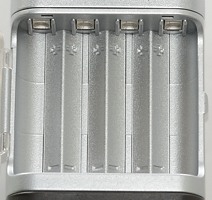
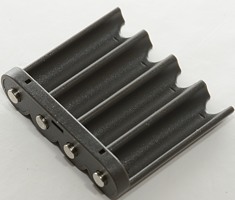

But with the supplied inlay it can also be used for AAA batteries. I am not impressed with that solution, the inlay is a extra piece to lug around and it can easily get lost. I would be more correct to just call it a AA charger and forget about AAA cells.
There is one more reason for that, the charger is a 4 cell charger, i.e. you cannot charge one or two cells. In practical applications it is most often one or two AAA cells, but frequently four AA cells.

The supplied solar panel cable use some very small barrel connectors. The cable is rather thick.
To test the solar input I cut this cable (To connect power to it) and was impressed with how much copper there is inside.


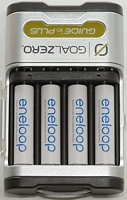

AAA requires inlay!
Measurements charger
- Charges four cells in series.
- Will discharge a full battery with less than 0.06mA
- Charge function will also work with switch in power bank or flashlight position.
.png)
The charger stops a bit early, it looks like it is using voltage termination.
The charger is charging with about 0.5A current, this means 4 to 5 hours charge time and not the 8 hours that the manual says.
.png)
Simulating a weak usb power supply will increase the charger time, but it is still way below the 8 hours.
Notice the usb current is exactly the same as above, it looks like the charger drains a constant current from the usb.
.png)
The charger current for AAA is about the same as for AA cells, because the current is only 0.5A this is fine. These smaller cells will be charged much faster.
I have no idea why the charger takes a break just before it is finished.
.png)
The GoalZero batteries has a bit more capacity than my eneloops and takes longer to charger. Termination is the same.
.png)
The manual says the batteries must be the same capacity, but not the same charge state, in this test I did not follow that, but used one 2500mAh cell and 3 2000mAh cells. The 3 low capacity cells got filled (mostly), but not the 2500mAh cell.
Voltage is the 2500mAh cell (powerex)
Voltage #2 is one of the 2000mAh cells (eneloop)
.png)
The manual says that the charger must always charge 4 cell, I did not follow that here. I have one eneloop in slot #1 and a dummy in slot #3. The charger can bypass empty slots with a lower current, but it will not terminate the charge
.png)
Lets try the part about different charge state, I have one full cell (The one I am measuring on) and 3 empty cells.
This is not very good, the full cell got nearly a complete charge again and the empty cells got slightly less charge than usual.
It does not look like the charger has any individual check of the cells.
Note: The temperature sensor is on one of the empty cells.
.png)
With 4 full batteries there is no problem terminating in a short time.
.png)
The manual says the solar input needs 6.5 volt and can draw 1.5A, I can easily simulate that with a power supply.
The charge current is increased, but not enough to get a 3 hours charge time, i.e. either the 3 hours are wrong or the solar panel delivers more voltage than 6.5 volt.
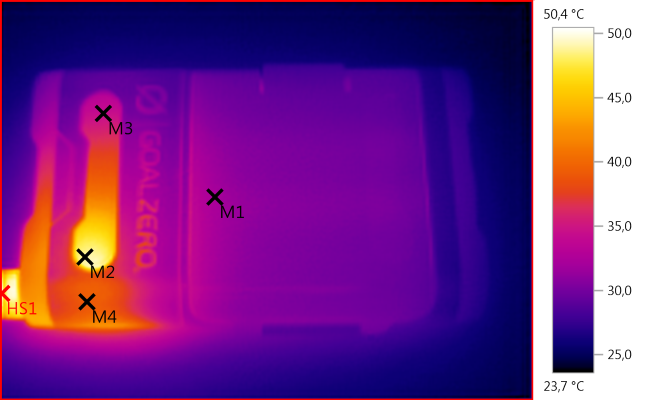
M1: 32,1°C, M2: 48,9°C, M3: 34,4°C, M4: 39,1°C, HS1: 50,4°C
It looks like all the charge electronic is placed very close to the power input connectors.
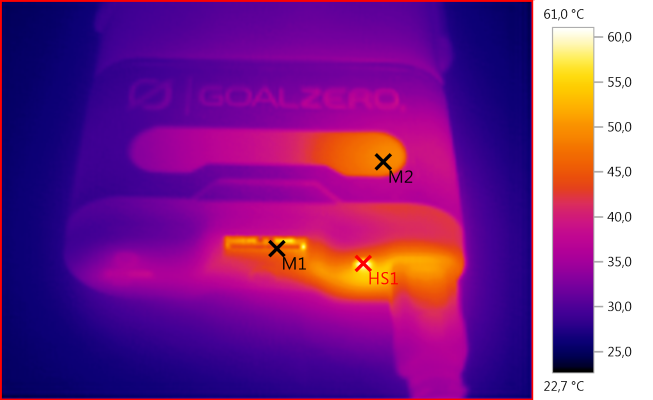
M1: 45,9°C, M2: 49,1°C, HS1: 61,0°C
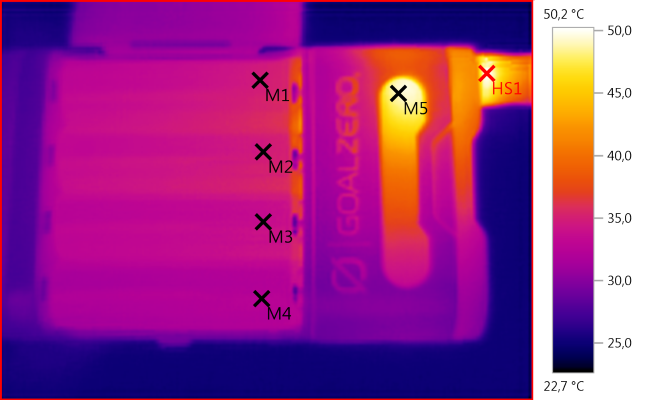
M1: 34,8°C, M2: 34,4°C, M3: 33,7°C, M4: 32,6°C, M5: 49,1°C, HS1: 50,2°C
I charged with the lid closed, but opened it for this shot. The batteries stays very cool.
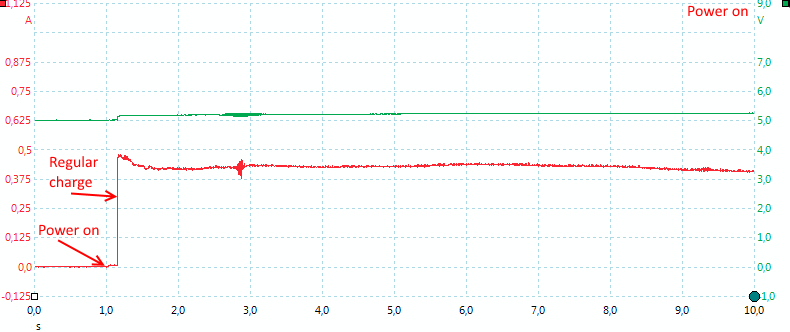
The charger is very fast to start (Voltage is across all 4 cells).
Measurements power bank
- Four AA cells in series are used for the power bank.
- The flashlight led uses 26mA
- When power bank function is turned on but idle, it will discharge batteries with 10mA
- When flashlight is on, power bank function is off
- Power bank function is on when charging, but at reduced power and up to 6 volt may be present.
- Setting switch in power bank position will make the usb output work normally when charging.
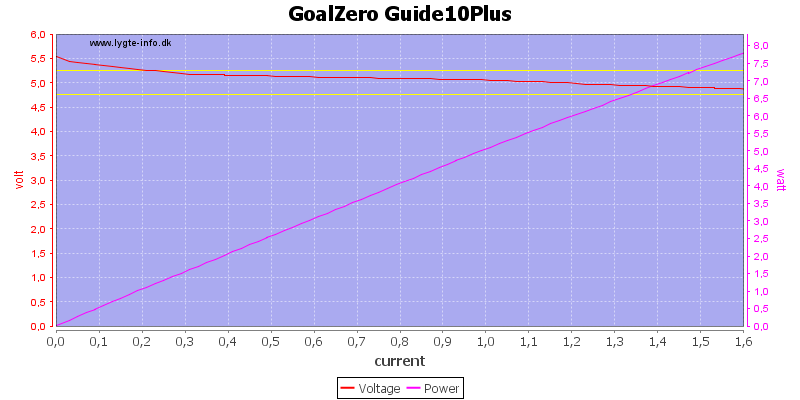
The output voltage start a bit high and drops slowly with load, I did not find any overload protection.
.png)
Output voltage is very stable with 0.5A load. The build in regulation can both increase and decrease voltage, this is very nice.
Voltage is the total battery voltage.
.png)
Increase the load to 1A will about halve the time it can supply power (As expected) and the output voltage is slightly lower.
.png)
Using the GoalZero batteries will give slightly longer runtime, due to the higher capacity.

The converter has some noise with 63mV rms and 550mVpp

Increasing the output current will increase the noise to 165mV rms and 900mVpp
Conclusion
I do not like the charger as a general charger, because it are not very good at handling batteries individually. It works fine with a four battery set, i.e. if the batteries have been drained together, this charge can charge them.
As a power bank it is fairly good, but it can only deliver about 1500mAh out at 1A.
It is a nice little device, but I have some problems with seeing the usefulness of it, I want a charger that can handle one or two AA or AAA batteries and as a power bank it cannot match a LiIon based one.
Notes
Here is an explanation on how I did the above charge curves: How do I test a charger
Read more about how I test USB power supplies and chargers



















.png)
.png)
.png)
.png)
.png)
.png)
.png)
.png)
.png)





.png)
.png)
.png)

